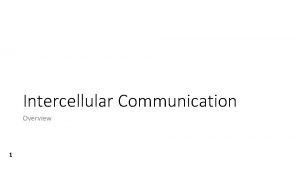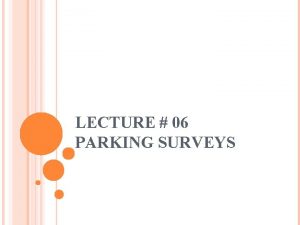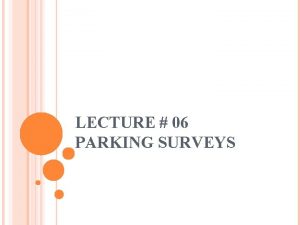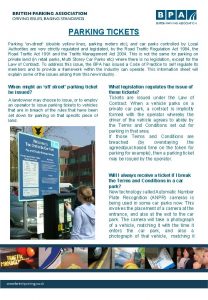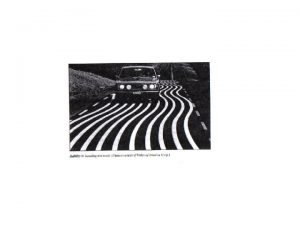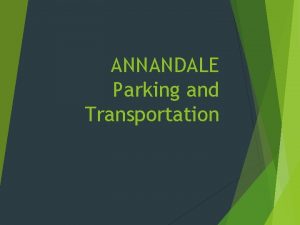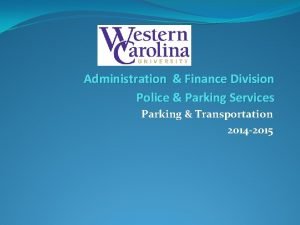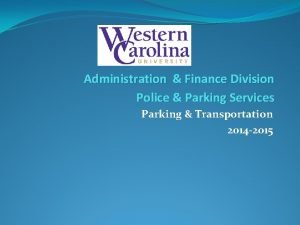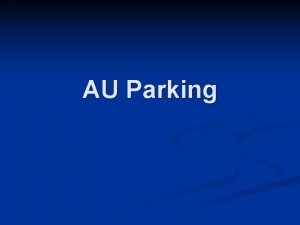SIGNALING TURNING AND PARKING SIGNALING One of the














- Slides: 14

SIGNALING, TURNING AND PARKING

SIGNALING - One of the most important and simplest forms of communication. - Lets other drivers know your intentions. - Not signaling is a very common mistake that everyone makes. - Hand signals are an acceptable substitute for lighted signals.

TURNING PREPARE FOR THE TURN 1. Check - Check for signs and markings 2. Choose - Choose the correct lane 3. Communicate - Check mirrors and signal 4. Position the Vehicle

TURNING - Reduce speed before making turn. Always finish your turn in proper lane Make sure in advance that the turn is safe. Be sure that signals are discontinued after the turn.

PARKING In order to park quickly, easily, and safely…. . - Good control Accurate judgment Understanding of steering Continuous practice

PARKING Types of Parking: - Right of Left Angle Parking - Perpendicular Parking - Parallel Parking

PARKING Right or Left Angle Parking - Along streets or towns - In parking lots 1. Stay 5 or 6 feet from parked vehicles; SIGNAL! 2. Proceed until you can see along side of the vehicle to the right of the space. 3. Straighten the wheels.

PARKING Perpendicular Parking - Very little room for maneuvering! 1. 2. 3. Stay 7 or 8 feet from parked cars; SIGNAL. Start turning when you can see down right side of vehicle to the right. Straighten wheels and center in your space.

PARKING Parallel Parking 1. Approach in the proper lane. 2. Move in front of the space and leave about 3 feet between vehicles. 3. Back up, steering sharply to the right. 4. Back up, steering sharply to the left. 5. With foot on brake, move up to center.

PARKING How would you park in other areas? - In a Driveway * Center * Parking Brake - In a Garage * Similar to Perpendicular * Good Positioning * Ability to Judge Space

PARKING Parking on a hill: - Make sure the vehicle does not roll into traffic - Downhill * Wheels to Right - Uphill (no curb) * Wheels to left

PARKING DO NOT PARK……… - within intersections. - on a crosswalk of sidewalk. - within 20 feet of crosswalk at an uncontrolled intersection. - within 30 feet of any flashing beacon, stop sign or traffic signal. - in front of a driveway.

PARKING DO NOT PARK……… - on any bridge or in a tunnel. - on the roadway side of any vehicle parked at the curb or edge of a highway. - beside a curb that is painted yellow or where official signs prohibit parking.

LEAVING THE VEHICLE - Set parking brake. Shift into park. Close all windows. Turn key into lock position and remove. Turn steering wheel slightly to lock it. Lock the door. Whenever possible, have passengers exit from curb side of the vehicle.
 The second coming things fall apart
The second coming things fall apart The second coming by w.b yeats
The second coming by w.b yeats Turning and turning in the widening gyre
Turning and turning in the widening gyre Twelfth night speeches
Twelfth night speeches Reiteration in discourse analysis
Reiteration in discourse analysis Discourse organizers
Discourse organizers Autocrine and juxtacrine signaling
Autocrine and juxtacrine signaling Juxtacrine communication
Juxtacrine communication Chapter 48 neurons synapses and signaling
Chapter 48 neurons synapses and signaling Chapter 48 neurons synapses and signaling
Chapter 48 neurons synapses and signaling To mix ingredients by gently turning one part over another
To mix ingredients by gently turning one part over another One empire one god one emperor
One empire one god one emperor One one little dog run
One one little dog run One king one law one faith
One king one law one faith Byzantine definition
Byzantine definition







